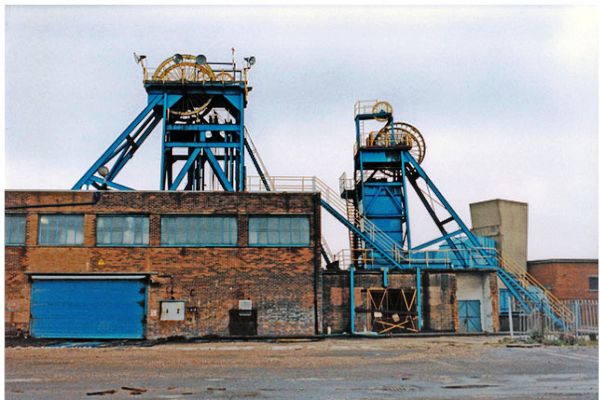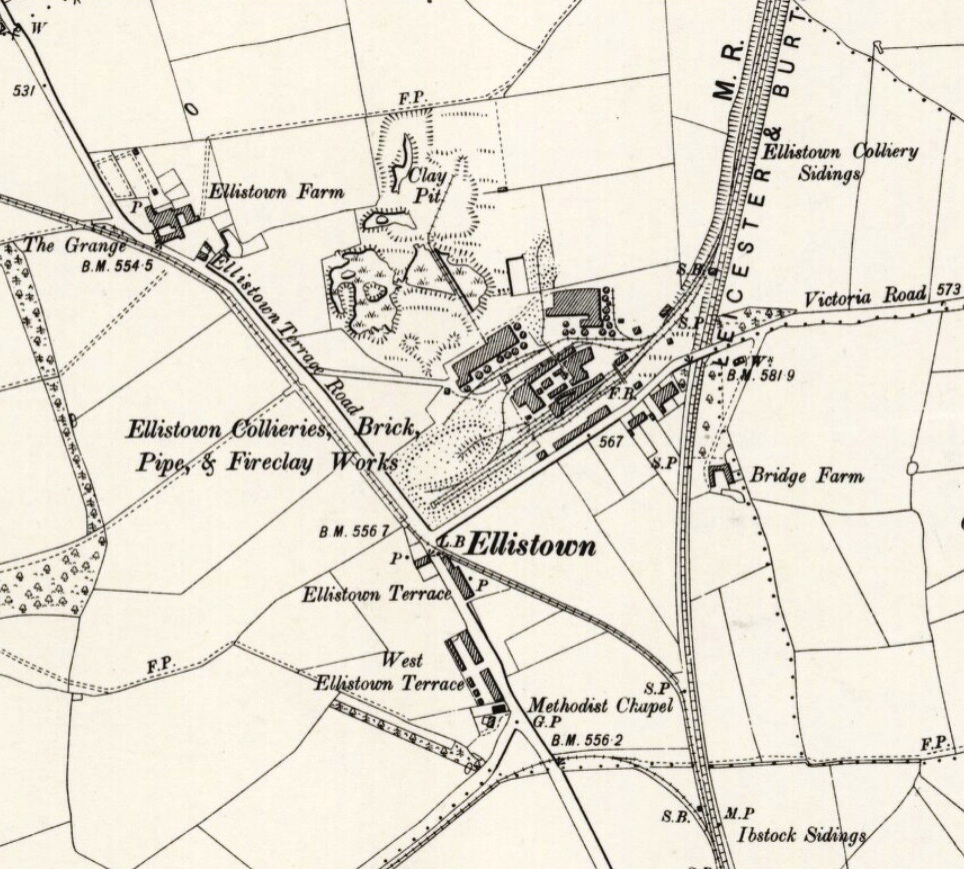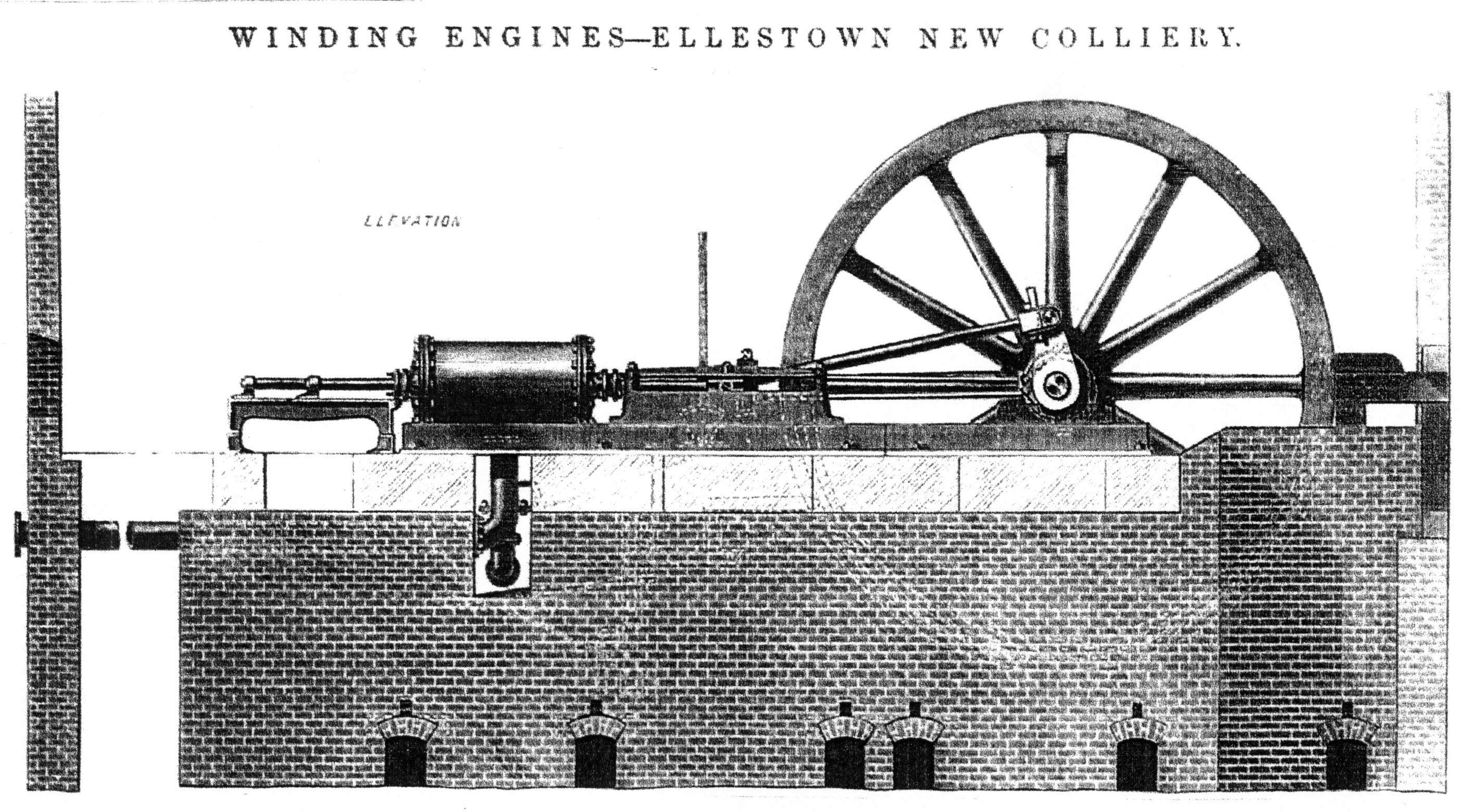ELLISTOWN COLLIERY (SK 438103)

Ellistown Colliery
Copyright © Darren Haywood and licensed for reuse under this Creative Commons Licence
Ellistown Colliery was commenced in 1874 by J.J. Ellis, who had been able to acquire either the lands or the mineral rights over a large area around the site of the colliery. (The name of the colliery was given as ELLESTOWN in at least one contemporary publication). The process of acquiring land and mineral rights continued for many years after establishing the colliery.
Shafts – The Ellistown shafts were sunk in the deepest part of the Eastern basin, the coal measures being entirely concealed below the New Red Sandstones. The geology was very favourable, the dip being approximately 1 in 14, with no faulting of the strata. Although overlain by the New Red Sandstones there were no major problems with water.
Two shafts had been completed by 1876, and a third shaft was commenced soon afterwards.
No.1 shaft was 13 feet diameter and was sunk to the Lower Main (or Roaster) Seam at 329 yards from the surface. The Lower Main Seam was 9ft. 2in. thick at this location. The Upper Main Seam was intersected at 256 yards and this seam had a thickness of 5ft. 6ins. In addition to several other workable coal seams, four seams of good quality fireclay were also intersected plus four seams of ironstone.
No.2 shaft was 10 feet diameter and was sunk to the same depth as No.1. The No.3 shaft was 13 feet diameter.
Winding – In 1874, Messrs. Death & Ellwood of Albert Works, Leicester, completed a twin cylinder horizontal winding engine (or pair of engines in the terminology of the time), for Ellistown Colliery. The cylinders were 34in. x 60in. with steel pistons and valve rods. Grid iron pattern slide valves were provided for steam distribution and these were fitted with Dawes’ Patent relief frames on the back. Stephenson’s valve gear was fitted for reversing.
The winding drum was 20 feet diameter over the wood lagging and was built up of 3 rings, each ring having 4 segments bolted together with 2in. diameter bolts. A complete ring had 12 spokes or arms. The centre ring was fitted with a brake path. Strap brakes were fitted operated by a steam cylinder and a compound lever system. Control was by a driver1s foot pedal.
Steam supply to the engine was controlled by a double seated equilibrium stop valve. A small pilot valve, which opened first, was fitted in the upper seating, relieving the main valve of out-of-balance pressure before lifting. The pilot valve could also be used for warming the cylinders before first starting.
Messrs Wood & Gee of Wigan supplied a winding engine in 1902. Cylinders 24in. x 42in., Maker’s Nos. 1030/1
Ventilation – No details have become available of the early ventilation systems at the colliery except that when the colliery opened, ventilation was by furnace. At some date a high speed fan made by the Waddle Patent Fan & Engineering Co. Ltd., Llanelli, was installed. The fan was of their patent open runner type and had an evasee rim for greater efficiency. Motive power was a Belliss & Morcom twin cylinder inverted vertical, high speed enclosed steam engine No.5381. This fan in turn was replaced by an electrically driven unit but was retained as a stand-by, serving in this capacity until the 1970’s.
Pumping – There was a make of water from the New Red Sandstones. A Cornish-type pumping engine was installed in 1879 presumably to deal with this water. This appears to have been replaced by a 2-throw ram pump located about 150 yards down the shaft. About 1905, a single cylinder horizontal engine was installed at the pit top to drive this pump. The engine was made by Fraser & Chalmers of Erith, Kent, the cylinder being 18in. x 36in. fitted with Corliss valves. All four valves were operated from a single wrist plate as in USA practice. Speed control was by a Porter-type governor operating on the trip gear of the steam admission valves. The flywheel was grooved for eight textile ropes but certainly in later years the pump crankshaft was driven through V-belt gearing. Engine speed was 75 rpm and 4 V-belts took the drive from a pulley alongside the flywheel to a pulley on a countershaft. A second set of V-belts transmitted the drive, with further reduction in speed, from the countershaft to the pump crankshaft.
Water was supplied to the adjacent brickworks and also into the public water supply system. The Coalville municipal authority had apparently made a payment towards the cost of the engine and this may explain its retention in working order until 1975, long after it had been replaced by electrically driven pumps. The engine was removed in 1976, ostensibly for preservation.
Underground Working – The Main and Lower Main (Roaster) Seams were the first to be exploited as is to be expected. In the early years the management got into trouble with the Inspector of Mines for failing to report an explosion and also failing to maintain adequate ventilation. There were also disputes over mineral rights and a lengthy dispute with the Leicestershire Miners Association in which the miners came out best.
Despite these early difficulties, Ellistown went on to be a very successful colliery and was the largest in the Eastern Basin of the Leicestershire coalfields. The extent of the reserves is indicated by the fact that the Upper Main Seam was still being worked in 1952.
Under National Coal Board management, the colliery was linked with South Leicester in 1957 by a roadway in the Middle Lount Seam. Later the underground workings were linked to Bagworth Colliery and thence to the surface at Nailstone Colliery by the Nailstone drift. The whole of the combined outputs were then brought to the surface at Nailstone.
Clay Working – Two works were established close to the colliery one of which made refractory linings, firebricks and sanitary pipeware. The second brickworks made blue bricks for building purposes.
| Seams Worked (1952) | Upper Main, Middle Lount |
| Workforce (1952) | 779 Underground, 214 Surface. |
| CLOSURE | 1991 (with Bagworth) |
Copyright © NMRS Records: Geoff Hayes Collection

OS Map, Leicestershire XXIII.SE 1901
Reproduced by permission of the National Library of Scotland


